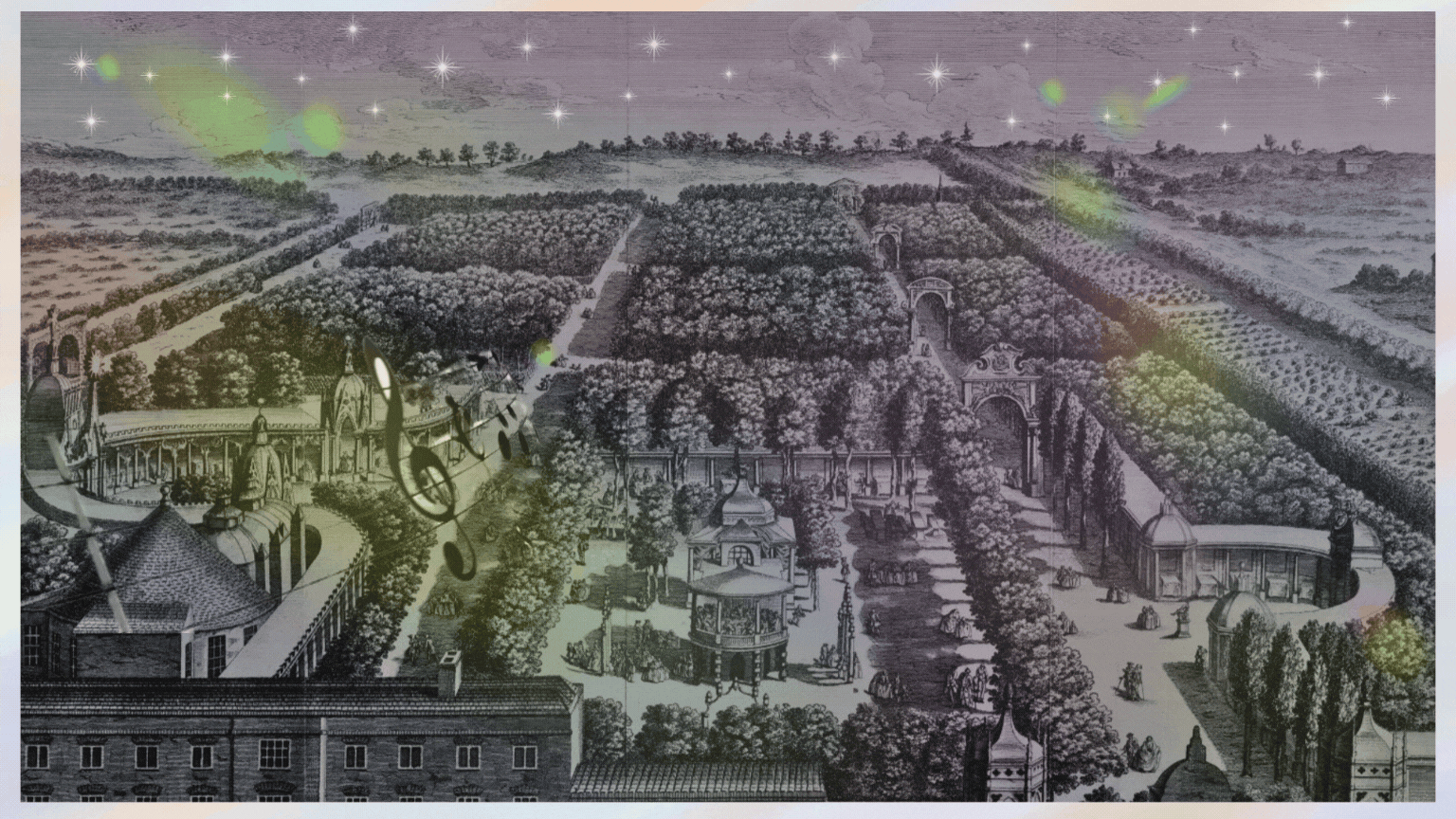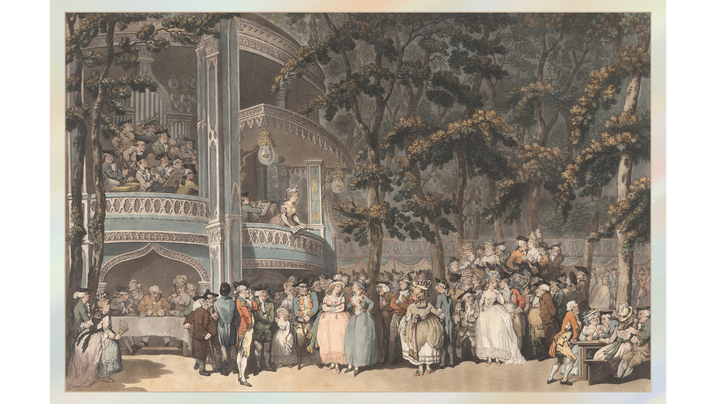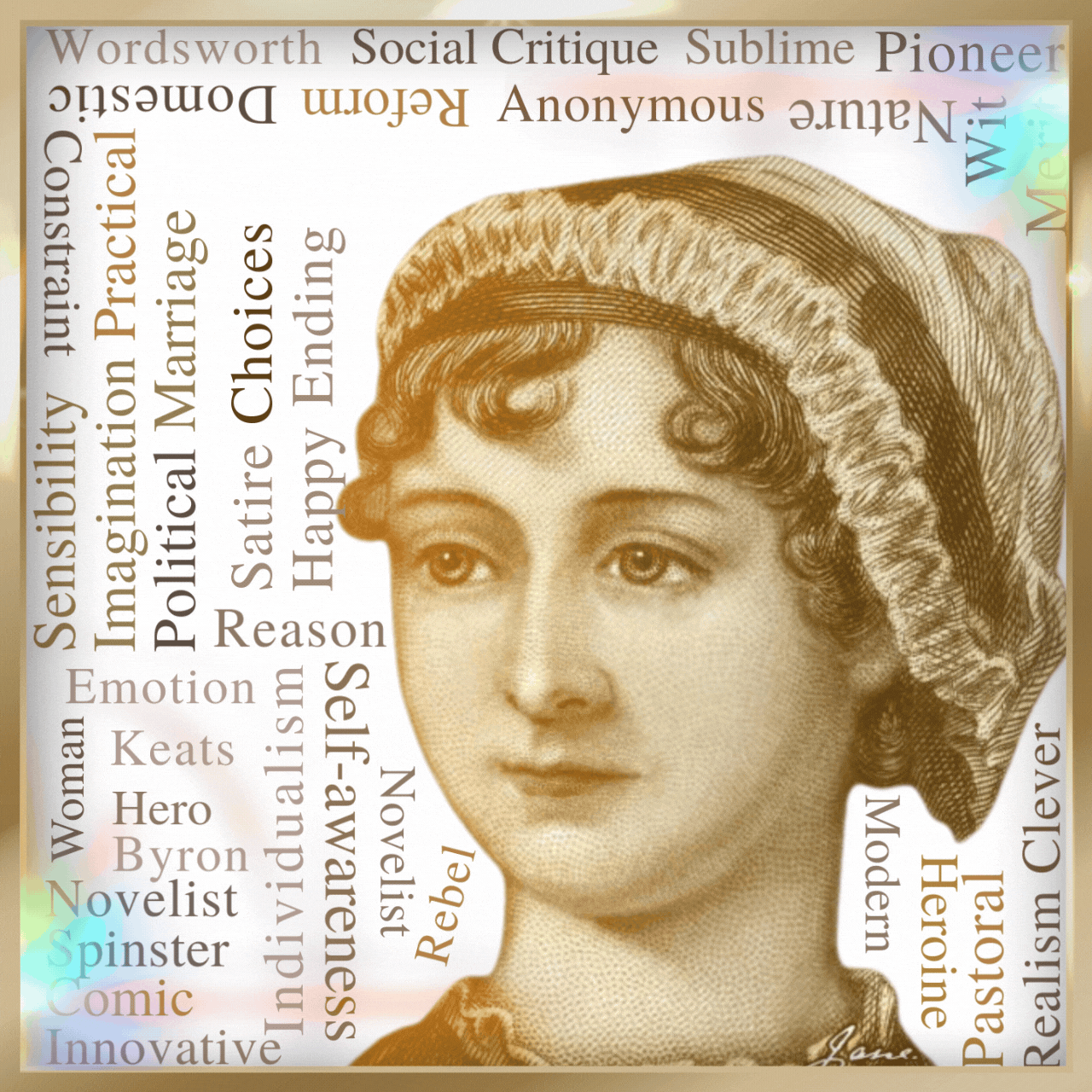Vauxhall: Pleasure Garden for All
The trees, the numerous lights, and the company in the circle round the orchestra make a most brilliant and gay appearance; and had I been with a party less disagreeable to me, I should have thought it a place formed for animation and pleasure. There was a concert; in the course of which, a hautbois concerto was so charmingly played, that I could have thought myself upon enchanted ground…
-From Evelina by Fanny Burney
Vauxhall Gardens was the most renowned of pleasure gardens. It was something that really no longer exists, but its relationship to modern leisure and entertainment is undeniable. To experience it as Evelina did in Fanny Burney’s 1778 epistolary novel, would be to enter a world far removed from not only present-day reality but even the reality of 18th century London. It must have been quite the spectacle! The history of Vauxhall Gardens began in the late 17th century when it was known as Spring Gardens. Twelve acres of land next to the Thames River in Surrey became not only a place of entertainment, but one with an intangible quality of illusion and magic.
Evelina, as was common, approached by boat, slowly leaving the crowded and chaotic streets of the city behind and moving toward the countryside where an almost otherworldly creation awaited. It was a place where not only the nobility might frequent, but it also welcomed the most common laborer, as long as they could afford the price of admission, a rare thing in a society long preoccupied with rank and position. It was a place one might go to experience a utopic respite, and at the same time, a place one might go to satisfy their most base desires.
Vauxhall’s nearly 200 years of existence was marked by changes that coincided with changes in society. In many ways it followed the trends of change, but it also was a place of innovation. It began with the emergence of empire and a commercial revolution and the expansion of empire, followed by political revolutions abroad and industrial revolution at home. During its time, Vauxhall saw the rise of the middle class from barely existing to dominating London. The following will explore some of the highlights and changes of Vauxhall Pleasure Gardens.
The opening of the gardens in 1661 is significant in that it directly followed the Restoration, and it blossomed in the following decades in which the annual trek of the beau monde to London became a firm tradition. Though the pleasure garden season lasted beyond the sitting of Parliament, the very fact of the migratory ritual meant that essentially all nobility had homes in London in addition to their vast estates. And, from this grew a culture of high fashion, of celebrity, and of seeing and being seen. The Pleasure Garden could be seen as an adult amusement park or somewhat of a precursor to a nightclub. There was dancing, but the main point of the pleasure garden was to perambulate. Yes, to walk…to walk, to strut, to strike a pose, and to make love to the metaphorical camera. Though there were no cameras to capture your likeness, there was Rowlandson whose illustrations would be disseminated all over London.
Light and Darkness

While the Gardens were at their height, night was their métier. Vauxhall masterfully used the contrast of darkness and light to its advantage. It aided the power of fantasy and the illusion of disappearing into another world. The most infamous part of the Gardens were the Dark Walks. Having fewer lamps and further darkened by the thick tree foliage, the paths on the perimeters of the grounds were where prostitution and other dubious acts were known to take place.
The rest of Vauxhall was more well lit, but enough darkness was left to allow the imagination to freely frolic in the realm of the fantastic. As the gloaming darkness descended upon the grounds, the lamps would be lit. No less than 1,500 lamps would be set ablaze within two minutes using connected fiber fuses coated in sulfur and saltpeter. The synchronized illumination of Vauxhall was a sight to behold. On special occasions lamps might have been arranged in patterns and colored glass might be used.
The low lighting and skillful placement of it added a realism to features that might otherwise be underwhelming. One such example were the trompe l’oeil paintings placed around the Gardens. Trompe l’oeil translates to “to deceive the eye”, and deceive it did. This and techniques of theatrical set building turned the garden’s temporary structures into more believable and immersive experiences. The Cascade, one of Vauxhall’s most famous attractions, used trompe l’oeil and control of light to create the illusion of water flowing downhill, when in reality, the water was actually thin sheets of tin glimmering under lamplight.
In 1798, fireworks became a regular feature, spreading brilliant color and light upon the dark canvas of the night sky. This signaled the beginning of the trend towards more and more elaborate attractions and more light. The darkness began to disappear and things began to change at a more rapid rate. The 2,000 lamps near the end of the 18th century increased to about 20,000 by the 1820’s and then to more than 30,000 by the 1840’s. What’s more, the lamps changed from oil to brighter gas and limelight. As the lights illuminated the paintings, dioramas, and walks, the veil of mystery was lifted. The magic dissipated and attendance began to fall.
In the early years of Vauxhall’s existence, entertainment was simple and informal. The soundscape included little but birdsong and the tunes of wandering minstrels. This changed after Jonathan Tyers became proprietor of the Gardens in 1728 and had a much grander vision of what they could be. It is said that he did more to encourage English art than any other man of his time. This included rebuilding The Orchestra, the pavilion for musical performance, into a grand two-storied structure with a dome. It had space for fifty performers and an organ. The new Orchestra helped amplify the music to the far reaches of the gardens. Later, Tyers also had The Music Room constructed as an ornate rotunda. This was influenced by the grand rotunda at Ranelagh, the only pleasure garden to rival Vauxhall.
While The Orchestra hosted formal concerts each evening with sets of about 18 pieces of music, the Gardens also used music in more unusual ways. For example, features along the walks included musicians embedded in the landscape. They were literally hidden underground in pits covered with shrubbery. This novelty did not last long, for it was detrimental to the delicate instruments, but music remained an important part of the Vauxhall experience. Instrumental concerts were a constant, and over time a preference for operatic vocals grew, lasting into the 1830’s.
During its existence, Vauxhall contracted many of the most famous composers of the day. In his reimagining of the pleasure garden, Tyers gave contemporary music its first truly mass audience with 100,000 visitors each season at its peak. One evening of music stands out among the others. The epitome of Vauxhall’s musical exhibitions was a rehearsal that was a premiere performance of Handel’s ‘Music for the Royal Fireworks’ in 1749. On this night, more than 12,000 people paid an admission of one shilling to hear the performance.

This statue was commissioned by Jonathan Tyers and placed in The Grove behind The Orchestra. Louis-François Roubiliac, Sculpture of George Frederick Handel, 1738, marble, Victoria and Albert Museum, London.
While music gave pleasure to the ears, sculpture and paintings gave the eyes much to indulge in. At that time, art had mostly been confined to private collections, but Vauxhall gave art to the people. One of the central artworks was a sculpture of Handel by Louis François Roubiliac. Spread amongst the Gardens was a scheme of paintings executed by William Hogarth and Francis Hayman. These paintings embellished the supperboxes surrounding The Orchestra, the Prince of Wales’ Pavilion, and the saloon of the Music Room. In subject, they included a range of tableaux from country leisure to scenes from Shakespeare’s histories.
Evolution and Ending in the 19th Century
Throughout its existence, the variety of entertainment at Vauxhall Gardens grew, becoming more and more exotic and sensational in nature. The audience of the 19th century began to lose interest in the idea of circulating around curated walks and sought more spectacular staged performances. One of the earlier examples of this sort of entertainment are the rope dancers, most notably the ‘Fire Queen’ Madame Saqui. A tight rope was strung at an incline from a mast along one of the long allèes. As she made her descent, a blaze of fireworks surrounded her.

Madame Saqui was a native France, but many performers came from even further abroad, like the sword swallower and juggler Ramo Samee from India. The taste for the exotic continued with an exhibition of American wonders, recreation of a Burmese temple, and performances of the Polish Mazourka just to name a few examples advertised on Vauxhall’s posters. Performers not only came from afar, but the Gardens would demonstrate the mode by which the viewer might be carried to far away places. In the final year of the long Regency, 1836, the Royal Vauxhall Balloon, naturally the biggest of its kind, was introduced and quickly rechristened the Great Nassau after a record-setting flight to Nassau, Germany.
By the 1830’s Vauxhall was struggling. Society had changed, and it had undergone many changes along with it, but in the end, the pleasure garden was no longer a viable product. Near its end, Vauxhall had years when it did not open at all, but would reopen and try again, with a protracted schedule and new entertainments. It finally saw its last day in 1859. However, pleasure gardens did not entirely disappear. They evolved into the theme park, paving the way for the likes of Tivoli Gardens, Blackpool, and Coney Island. Vauxhall's legacy was beautifully summed up in the words of Charles Dickens who said:
The temples and saloons and cosmoramas and fountains glittered and sparkled before our eyes; the beauty of the lady singers and the elegant deportment of the gentlemen, captured our hearts; a few hundred thousand of additional lamps dazzled our senses; a bowl or two of reeking punch bewildered our brains; and we were happy.
Sources:
Dunn, N., & Edensor, T. (Eds.). (2020). Rethinking darkness : Cultures, histories, practices. Taylor & Francis Group.
Conlin, J. (2006). Vauxhall Revisited: The Afterlife of a London Pleasure Garden, 1770–1859. The Journal of British Studies, 45(4), 718–743. doi:10.1086/505955
CONLIN, J. (2008). Vauxhall on the boulevard: pleasure gardens in London and Paris, 1764–1784. Urban History, 35(1), 24–47. doi:10.1017/S0963926807005160
Southworth, J. (1941). Vauxhall Gardens: A Chapter in the Social History of England. New York Chichester, West Sussex: Columbia University Press.
Stamp, G. (2011). Architecture - Vauxhall Gardens. In Apollo (London. 1925) (Vol. 174, Number 590, pp. 96–97).
Eschner, Kat. “A Picture History of One of the World’s Greatest Hot Air Balloons.” Smithsonian Magazine, 31 Jan.
2017,www.smithsonianmag.com/smart-news/picture-history-one-worlds-greatest-hot-air-balloons-180961908/.
Greig, H. (2012). “All Together and All Distinct”: Public Sociability and Social Exclusivity in London’s Pleasure Gardens, ca. 1740–1800. Journal of British Studies, 51(1), 50–75. doi:10.1086/662434
Ogborn, M. (1997). Locating the Macaroni: Luxury, sexuality and vision in Vauxhall Gardens∗ . Textual Practice, 11(3), 445–461.
Symes, M. (2024). The London Pleasure Gardens. In Prints and the Landscape Garden (pp. 92–105). Chapter, Boydell & Brewer.
Slessor, C. (2018). Pleasure principles. The Architectural Review, 244(1451), 9-.
Hughes, E. (2012). Chapter 3. Guns in the Gardens: Peter Monamy’s Paintings for Vauxhall. In J. Conlin (Ed.), The Pleasure Garden, from Vauxhall to Coney Island (pp. 78-99). Philadelphia: University of Pennsylvania Press.
Myrone, M. (2022). Exhibitions Culture, Consumerism and the Romantic Artist. In M. McCue & S. Thomas (Eds.), The Edinburgh Companion to Romanticism and the Arts (pp. 184–200). Chapter, Edinburgh University Press.
Cowgill, R. (2012). Chapter 4. Performance Alfresco: Music-Making in London’s Pleasure Gardens. In J. Conlin (Ed.), The Pleasure Garden, from Vauxhall to Coney Island (pp. 100-126). Philadelphia: University of Pennsylvania Press.
Stearns, Peter. “Building Industrial Society: The Industrial Revolution.” The Industrial Turn in World History. United Kingdom: Routledge, 2017. 43–69. Web.
Borsay, P. (2012). Chapter 2. Pleasure Gardens and Urban Culture in the Long Eighteenth Century. In J. Conlin (Ed.), The Pleasure Garden, from Vauxhall to Coney Island (pp. 49-77). Philadelphia: University of Pennsylvania Press.
Cowgill, R. (2012). Chapter 4. Performance Alfresco: Music-Making in London’s Pleasure Gardens. In J. Conlin (Ed.), The Pleasure Garden, from Vauxhall to Coney Island (pp. 100-126). Philadelphia: University of Pennsylvania Press.
Solkin, David H. "Chapter 4: Vauxhall Gardens; or, The Politics of Pleasure." Painting for Money: The Visual Arts and the Public Sphere in Eighteenth-Century England by David H. Solkin, Paul Mellon Centre, 1993. A&AePortal.



















